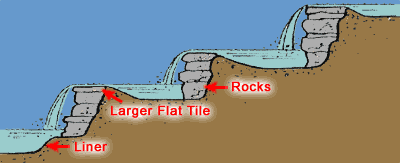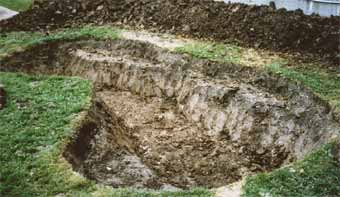
Step 1
Try to locate in full sun, away from overhanging trees. Use a rope or hose to create the desired outline. A depth of 18″ or more is recommended. Shelves for marginal plants should be approximately 12″ wide and 8″ deep or more. Slope the sides for stability. Be sure to level the top edge of the pond to avoid having exposed liner.
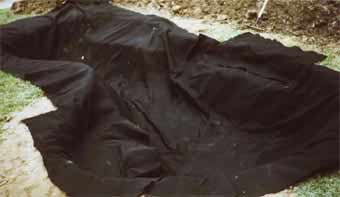
Step 2
A cushion of sand or geotextile felt (see pg 24), seen above, may be used to line the excavation and protect the liner.
Drape the liner loosely and evenly over the pond. The liner is more flexible on a warm day. Anchor the liner with small weights. Do not place the weights near the edge of the pool.
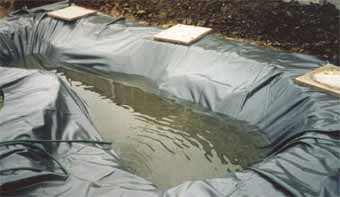
Step 3
Start filling the pond with water, removing the weights as necessary to allow the liner to take the shape of the pond. Adjust the creases and wrinkles in the liner as the pond fills. When the pond is full and settled, excess liner may be trimmed, leaving a 12″ flap. Secure flaps until edging or coping is in place.
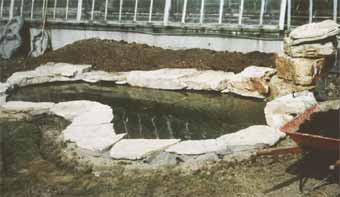
Step 4
Complete the finishing treatment of the pond’s edges using the method of your choice (see below). Concealing the liner gives a more natural appearance and protects the liner from U.V. rays. It may be necessary to rinse the pond and refill it before stocking with plants or fish.

SOD
Pool Liner may be tucked in a trench 8”-12” from the edge and covered with topsoil. Some topsoil may spill into pond.

FALSE SHELF
Build a false shelf to support rock, which will completely hide the liner. This achieves a more natural look and protects the liner from U.V. damage.

ABOVE GROUND PONDS
Blocks, railway ties or cedar may be used to form the sides of above ground pools. Be sure to add a sitting edge.
Waterfalls may be added to the pool with a submersible pump. Small pumps will give a nice effect at 2′ – 3′. Large pumps should be used for greater heights to create the desired effect. See Determining the Correct Pump for your Pond. Diagram of a watercourse showing the way a liner is used to waterproof a channel. Smooth rocks or stones may be used to conceal the liner and create pouring lips for the waterfall. Be sure the waterfall lining extends all the way into the pond to avoid the possibility of leakage. Avoid having water run behind rocks by using a sealant.
(See Waterfall Foam Sealant in POND ACCESSORIES)
